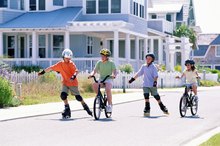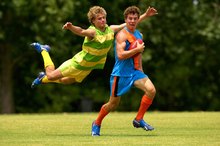What Is a Physical Fitness Program?
Physical fitness is measurement of the performance of your lungs, heart and muscles both during exercise and while at rest. An exercise routine designed to increase or maintain your performance in these areas is commonly known as a physical fitness program. Following this type of program for life can seriously lower your risks for a number of chronic health conditions.
Understanding Fitness
You are physically fit if you can perform everyday tasks easily and have plenty of energy left over for leisure activities and physically demanding emergency situations, according to the President’s Council on Physical Fitness and Sports. Typically, fit individuals have superior endurance and lower stress levels when compared to unfit individuals. Basic factors that influence your fitness potential include your age, genetic inheritance, gender, eating patterns and level of exercise. A physical fitness program uses exercise as a means of utilizing your innate physical potential.
- You are physically fit if you can perform everyday tasks easily and have plenty of energy left over for leisure activities and physically demanding emergency situations, according to the President’s Council on Physical Fitness and Sports.
- Basic factors that influence your fitness potential include your age, genetic inheritance, gender, eating patterns and level of exercise.
Fitness Components
Why is Regular Exercise Important For Children?
Learn More
The President’s Council lists specific components of physical fitness that include muscular strength and cardiovascular endurance, which describes your heart and lungs’ ability to deliver oxygen and nutrients efficiently and remove waste products for an extended period of time. Additional components of fitness include joint and muscle flexibility and muscular endurance, which describes your ability to use your muscles for repeated or sustained tasks. Your physical fitness is also indicated by your body’s ratio of lean mass to fat.
Adult Fitness
If you are an adult between the ages of 18 and 64, the Centers for Disease Control and Prevention (CDC) recommend a number of steps to achieve a baseline level of physical fitness 1. Begin by performing at least 150 minutes a week of a moderate-intensity aerobic activity, such as bicycling or brisk walking. In addition, perform a strength-building exercise, such as weightlifting or push-ups, at least twice a week. To achieve greater levels of fitness, you can increase your weekly amount of moderate-level aerobics or perform 150 minutes a week of a high-intensity activity, such as running or jogging. If you are 65 or older, your parameters for exercise are essentially the same as those for younger adults.
- If you are an adult between the ages of 18 and 64, the Centers for Disease Control and Prevention (CDC) recommend a number of steps to achieve a baseline level of physical fitness 1.
- To achieve greater levels of fitness, you can increase your weekly amount of moderate-level aerobics or perform 150 minutes a week of a high-intensity activity, such as running or jogging.
Teen and Child Fitness
What Does Weight Watchers Consider an Intense Workout?
Learn More
To achieve baseline physical fitness, teenagers and children need at least one hour of activity per day, the CDC reports. Most of this activity should come in the form of moderate-intensity aerobic exercises. However, at least three days a week, your child should participate in a more vigorous form of aerobic exercise. He should also perform a strength-building activity, such as push-ups or gymnastics, at least three days a week. In addition, your child will need to engage in an activity that builds bone strength at least three times a week. Examples here include running and jumping rope.
- To achieve baseline physical fitness, teenagers and children need at least one hour of activity per day, the CDC reports.
- He should also perform a strength-building activity, such as push-ups or gymnastics, at least three days a week.
Considerations
Healthy adults under the age of 35 are typically free to start a physical fitness program, the President’s Council notes. However, individuals over 35, habitually inactive individuals and those under 35 with known health conditions will need to speak with their doctors before beginning an exercise program. Ailments that can alter your exercise program include hypertension, arthritis, frequent dizziness and heart disease. Consult your doctor if you have any doubts about your health status.
- Healthy adults under the age of 35 are typically free to start a physical fitness program, the President’s Council notes.
- However, individuals over 35, habitually inactive individuals and those under 35 with known health conditions will need to speak with their doctors before beginning an exercise program.
Related Articles
References
- Centers for Disease Control and Prevention: Physical Activity for Everyone; How Much Physical Activity Do You Need?
- Roth, Walton, et al. Fit & Well: Concepts and Labs in Physical Fitness and Wellness 5th Ed. Boston: McGraw-Hill College, 2002.
Resources
Writer Bio
M. Gideon Hoyle is a writer living outside of Houston. Previously, he produced brochures and a wide variety of other materials for a nonprofit educational foundation. He now specializes in topics related to health, exercise and nutrition, publishing for various websites.









